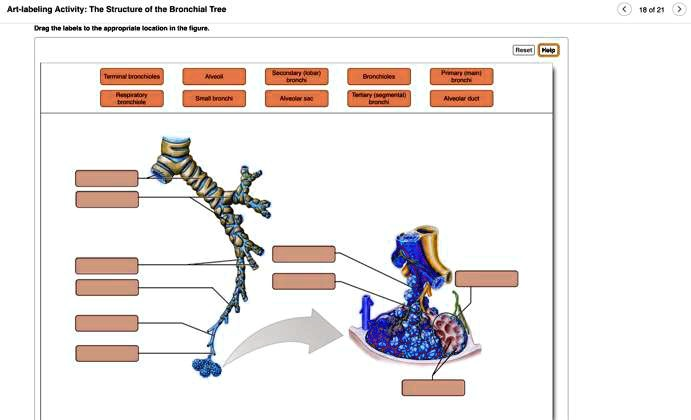The Structure of the Bronchial Tree Drag the labels to the appropriate location in the figure. Terminal bronchioles Respiratory bronchiole Alveoli Secondary (lobar) bronchi Bronchioles Small bronchi Alveolar sac Tertary (segmental) bronchi Primary (main) branch Alveolar duct Reset Help 18 of 21

The Correct Answer and Explanation is:
Here is the correctly labeled structure of the bronchial tree in the figure:
- Primary (main) branch – main bronchus entering the lung from the trachea
- Secondary (lobar) bronchi – branches from the primary bronchus leading to each lobe
- Tertiary (segmental) bronchi – branches supplying specific bronchopulmonary segments
- Small bronchi – smaller divisions beyond the tertiary bronchi
- Bronchioles – branches smaller than 1 mm without cartilage
- Terminal bronchioles – final part of the conducting zone, leading to respiratory bronchioles
- Respiratory bronchiole – first part of the respiratory zone, containing alveoli outpouchings
- Alveolar duct – thin-walled ducts connecting respiratory bronchioles to alveolar sacs
- Alveolar sac – clusters of alveoli at the end of alveolar ducts
- Alveoli – microscopic air sacs where gas exchange with capillaries occurs
Explanation: The bronchial tree is a hierarchical structure that efficiently channels air to the microscopic regions of the lungs where gas exchange takes place. Starting from the trachea, air passes into the primary bronchi, which split into secondary bronchi, each entering a different lobe of the lung. These further subdivide into tertiary bronchi that serve specific anatomical segments within the lobes.
With each branching, the airway diameter decreases and the structure transitions from cartilage-supported bronchi to muscular bronchioles. The small bronchi and bronchioles ensure air reaches the deeper lung regions. Terminal bronchioles mark the end of the purely conducting zone. Beyond this, respiratory bronchioles contain scattered alveoli, initiating the gas exchange process.
Air then flows through alveolar ducts, which lead into alveolar sacs. These sacs house multiple alveoli, where oxygen diffuses into the surrounding capillaries and carbon dioxide exits the blood. This intricate branching maximizes surface area and minimizes airflow resistance, ensuring efficient pulmonary function.
Understanding the bronchial tree is key for comprehending ventilation, the effects of respiratory diseases, and medical procedures like bronchoscopy or targeted drug delivery.
